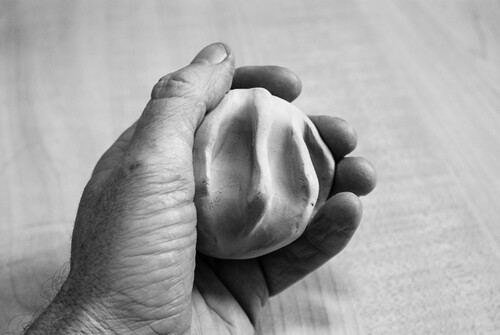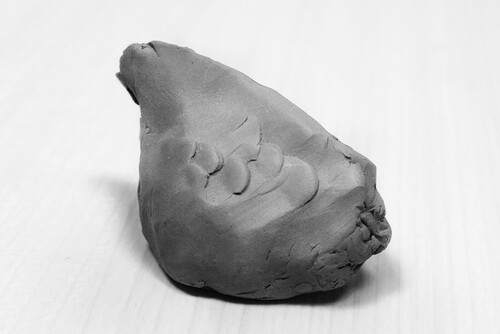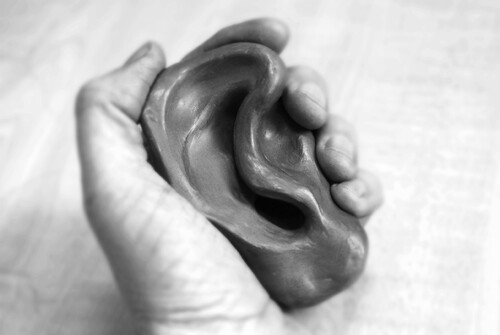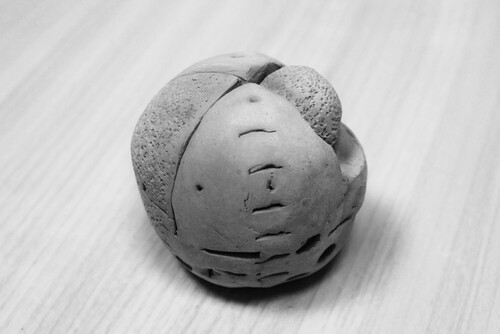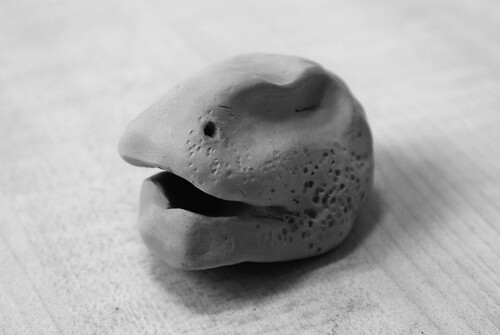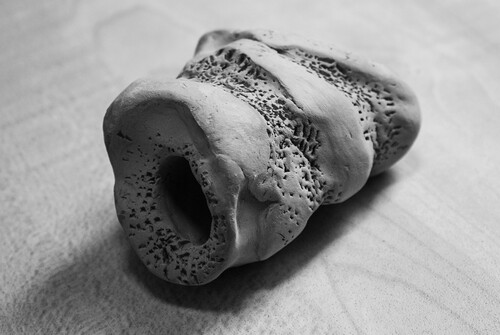ABSTRACT
Background
Therapist art making in individual sessions with adult service users has received little attention in the art therapy literature. Similarly, art therapy’s efficacy with anxiety problems has not been established.
Context
NHS Criminal Justice Community Mental Health Team, long term weekly individual art therapy.
Outcomes
Service User reported marked reduction in anxiety, CJCMHT observed significant reduction in anxiety and increased social functioning leading to discharge from forensic services.
Conclusions
Therapist art making helped reduce anxiety by increasing trust. The ambiguity of the artwork challenged black and white ways of relating to self and others. Therapist artmaking functioned as a non-verbal form of psychoeducation. Three styles of therapist art making can be described, all of which are characterised by improvisation: Alongside the Service User; Jointly with the Service User; Under the gaze of the Service User.
Implications for research
Art making can be helpful in 1:1 therapy with adult service users because it magnifies the art therapist’s ostensive (i.e. non-verbal) communications and increases trust. Making art alongside service users provides a unique way to engage with complex psychological and interpersonal material. It is the ambiguity of therapist artwork that seems particularly helpful, and it should be considered as a promising way to address black and white thinking in common mental health problems like anxiety and depression.
Plain-language summary
This paper describes the benefits of therapist art making in individual sessions with an adult user of mental health services. Lived Experience feedback is used to show how therapist art making helped reduce severe anxiety and improve social functioning. The paper describes the clinical reasoning for three art-based interventions; how they built and maintained trust, meaning and hope for both therapist and Lived Experience Author. The paper suggests that the ambiguity of therapist artwork can be thought about in terms of the presenting problem, particularly to reframe black and white ways of relating to self and others.
Introduction
The intervention described in this paper was delivered in a NHS Criminal Justice Community Mental Health Team (CJCMHT). The Lived Experience Author, referred to by the pseudonym Phil, struggled with problems of severe anxiety. Phil is a white, working class man in his late middle age, I am a white, middle class man of similar age. Three years after therapy the opportunity arose to ask Phil about his experience of art therapy in order to inform theory co-productively. I met him for two semi-structured interviews before lockdown and continued the conversation by phone three times during it. Phil’s verbatim words appear throughout the paper in italics.
Theoretical framework
The aim of art therapy was to help Phil better manage his anxiety. Despite the prevalence of anxiety disorders, a recent systematic review (Abbing et al., Citation2018) concluded that art therapy’s efficacy on anxiety has hardly been studied. In a previous paper (Marshall-Tierney, Citation2014), I hypothesised that it might be helpful to make art alongside individuals in community mental health settings. Having suggested that therapist artmaking in acute settings should not become emotionally charged and therapists should let go of their artwork as soon as a Service User needed more direct attention, I now propose that these caveats need not apply to work with individuals in community settings.
Some controversy remains about artmaking alongside adults in individual sessions. Greenwood says she has never done so ‘because past abusive relationships may all too easily be re-enacted in the transference’. (Greenwood, Citation2017, p. 144). Conversely, Michaels says that therapist artmaking is a way of ‘working with transference dynamics … that does not rely on cognition or language’ (Michaels, Citation2010, p. 72).
Aside from this, the literature proposes a number of relational benefits to therapist artmaking: building trust by reducing the anxiety of the gaze (Havesteen-Franklin, Citation2014; Moon, Citation2002), making the therapist and their mind more available to the service user (Greenwood & Layton, Citation1987 & Malchiodi, Citation2014) and playful mirroring which stimulates empathy (Bragge & Fenner, Citation2009; Leclerc, Citation2006; Mahony, Citation2011; Morter, Citation1997; Rogers, Citation2002).
Using evidence from neuroscience Franklin explains that joint artmaking activates mirror neurons through which the actions of another are experienced identically within the observer.
When humans see or hear another person performing a specific action, the same motor circuits are simultaneously activated in their bodies. It is not necessary to physically replicate what is observed or heard to have this effect; our motor systems engage as if the action had been replicated. (Franklin, Citation2010, p. 163)
Springham and Huet (Citation2018) likewise examine art therapy through the lens of Ostensive Communication Theory. This hypothesises a difference between contingent and marked mirroring in infant/caregiver relationships; whereas the caregiver’s contingent responding is an accurate reflection of the infant’s gestures, their marked mirroring is a performance of this, which for the caregiver is not for real. Applied to therapeutic relationships, it is only the repeated and explicitly benign ‘interaction of gestures, tone of voice, and gaze direction’ that tells our clients they can trust us, because ‘seeing is believing’. The making and viewing of art in art therapy engages the attachment system and builds a more trustworthy base for the relationship ‘because the art object so readily signals a not for real quality’ (Springham & Huet, Citation2018, p. 9).
For the purposes of this paper, I am suggesting that if the artmaking behaviour of the therapist could be said to be a contingent response to the service user, then the therapist’s artwork might then be a form of marked mirroring. Or put another way, perhaps it is the unambiguity of the therapist’s artmaking behaviour that makes therapy safe, and it is the ambiguity of their artwork that makes it meaningful.
Practice description
When Phil began art therapy he was living alone, with no friends and estranged from his entire family. He woke each morning sick with dread, ruminated all day, had panic attacks whilst shopping and lived in fear of exposure as a sex offender. As a child Phil was criticised relentlessly by his father, who was otherwise distant and only came alive when Phil’s older sister was present. His mother was sympathetic but ineffectual. He mostly played alone and often cried himself to sleep. Phil was bullied throughout school and the only safe place was the art room.
I could relax in there, it felt like I was away from school, the art teacher would treat you with respect.
Phil was offered linked psychoeducational and art therapy interventions with some medication support. His art therapy (one hour weekly) lasted three years and he never missed a session. The setting was the out-patient wing of a Low Secure Unit (LSU), entered through an airlock where visitors and staff had to surrender keys and phones, all doors were self-locking and all rooms were monitored by CCTV.
The building frightened me. It looked like a really tough school. The moment I walked up, that building put my shield up.
After initial experimentation with a range of materials, clay was soon established as the art material of choice. Phil was the only art therapy out-patient because I was contracted to work mainly with in-patients. Consequently, he had sole use of the bag of clay.
Procedure 1: therapist watching – service user making
During assessment Phil made a succession of clay objects, but quickly destroyed them saying it was as if his father had just walked into the room and told him to stop wasting his time. My hypothesis was that it was this critical voice that underpinned his anxiety, and we agreed that using the clay playfully might be a good way of lessening its grip. Post-therapy Phil said that at first, he had been unpersuaded by my formulation.
I thought this is going nowhere; what’s a piece of clay going to do?
Because you was educated I was scared you’d judge my work.
Your voice was calming, like you meant what you was saying.
I took the issue to supervision; Phil was so harsh on himself and so easily shamed. Clearly, I needed to behave differently. If I used clay alongside him would he feel safer? Or to use a trope I will return to, would there no longer be middle-class eyes watching anxious working-class hands?
I discussed this with Phil and he agreed that it might be helpful.
Procedure 2: therapist making art alongside service user
Since being watched made Phil anxious I tailored the intervention to create more equality in the making and viewing of artwork. I would improvise with the clay, rather than attempt to represent or attune to Phil’s anxiety as he needed to find his own form for this.
The following session Phil arrived looking, as usual, sick with dread. As planned, we both used clay alongside each other. I made the first of what turned out to be a series of similar pieces that Phil called seeds.
Seeing you use the clay made me feel like you was trying to support me. I thought, he’s read the book and I haven’t, so I don’t have to worry. It showed you knew what you were doing, in a good sense.
You didn’t seem worried about it, you just seemed to accept it and I thought I could learn to do that.
We built on this good start over the ensuing months and Phil began to sporadically attend a community farm. Although he avoided other people, Phil felt safe close to the animals and he similarly felt calmer holding the clay in his hands: attachment theory links proximity-seeking behaviour to touch. Phil often picked up my artwork and experimented with various placings next to his.
I wanted to look at it closely, and then I could place it close to mine as a way of saying thank you for accepting me.
That was a good thing, it made it more powerful that yours were sharing the same space as mine, it was comforting to me.
Putting it in the bag is not black and white thinking, clay’s a medium you can work with every week, it can change, you can start again, it’s not a permanent thing so my thoughts aren’t permanent.
Initially I didn’t believe you, very dubious, but when you asked and I suggested smoothing and then saw you doing it, then it made me feel acceptable and I thought this man’s learning off of me!
I felt relaxed taking the ear to supervision, but unusually uncomfortable when my colleagues held it. We talked about how Phil was comforted by stroking animals and how smoothing clay could be linked to the need to be comforted and also how this was probably linked to Phil’s sexual offence, something good gone bad. Post therapy Phil confirmed this,
I also thought that I should not get comfort from using the clay like this.
In contrast to my anxiety, Phil began the next session feeling refreshed after his first good sleep in years. He decided to take the Chicken home. Over the following months he went more regularly to the farm where he felt increasingly safe with the other service users.
During subsequent sessions I found myself thinking that handling clay always seemed to entail some sexual ambiguity. Post-therapy he said that he was often anxious that the clay would
… develop into something horrible like I did.
He gradually stopped using clay and alluded increasingly to his bad side and how he had destroyed his family.
It became clear that he was stuck again.
Evaluation of Procedure 2
Artmaking did not compromise my ability to use the calm tone of voice that Phil valued, but it allowed me a greater repertoire of gestures, increasing the likelihood that my interactions were congruent and lively. Artmaking kept my hands in full view, within touching distance of Phil’s hands and artwork. These changes in my behaviour can be seen as a form of contingent mirroring and are probably linked to the positive changes in Phil’s behaviour; his reduced anxiety, his improved functioning and his post-therapy feedback about feeling safer.
My artmaking also helped Phil create artwork that was more imaginative and meaningful to him than when I just watched. The Chicken and Ear are both visually ambiguous and psychologically complex. Both pieces could be described as ‘not for real’ and a form of marked mirroring that helped us understand things better. With artwork that was made and viewed in the same intersubjective space, we did not need a concept like the transference to view both Chicken and Ear through the lens of the presenting problem.
This intervention helped dismantle some of my institutional and professional power. To return to the trope I used earlier, middle-class hands and working-class hands were now working closely with the same material. There was also no inequality, class or otherwise, in the gentle placing of our artwork side-by-side in the bag of clay.
My proficiency with materials was initially an advantage; Phil’s feedback says that it showed him I was a safe pair of hands. He found it particularly helped as a form of non-verbal psychoeducation through which he saw me consistently modelling a more relaxed and accepting attitude towards making and viewing artwork. My ability to improvise, my knowledge of the material, my expertise in not-knowing were ways of me showing him (rather than telling him) that things could be different, that things were not black and white.
Conversely, my proficiency was the result of a privileged art school education. Every time I demonstrated skill, I drew attention to an advantage that had not been available to him. Phil also commented that it would have been much more helpful if his flat had been the venue for art therapy.
If it had been at home it would have been better, and I would have been looking after you, it would have given me some standing and might have stopped your artwork being better than mine.
I always got the impression that you knew what you were doing, but you couldn’t have pretended otherwise, it needed to be done because otherwise I’d have got into a rut.
Procedure 3: therapist and service user jointly making art
In supervision we discussed the ambiguity of my artmaking. Linking this to his offence seemed premature given how overwhelming his sense of shame could be, as I now knew myself. We wondered if sharing the artmaking might reframe unhelpful ideas about ownership and challenge his all-or-nothing thinking.
This phase of the intervention was tailored specifically to Phil’s needs; the aim was to stop him ruminating about my artwork being better than his. The plan was simple, we would swap our artwork whenever his thinking became black and white.
This was a practice innovation for me, and I told Phil so when I explained the plan. He agreed to give it a go. Taking similarly sized balls of clay, we began tentatively. Phil immediately said that his was useless. So, I gave him mine. He looked fleetingly unsettled but carried on, soon repeating that his was useless and mine was better. So, we swapped again. Phil said that the experience was confusing because he had no default way to think about it, but he did not report any increased anxiety. I kept up the momentum, and we pressed shallow indentations with our fingers and sculpted patterns with shared modelling tools.
You using the modelling tools showed your willingness to share things with me. It made me feel like you were accepting me and made me feel less vulnerable.
It was a good thing to say because it meant we were getting close in thoughts.
We worked in this way for about two months. All the artwork was broadly similar, mostly spherical and non-figurative; squeezed, sliced, scored, decorated, but not named individually. In supervision we wondered if making similar things was a way of exploring what it is like to be the other person. During this period Phil consistently recognised that there were pockets of good experience in his life, and he imagined buying a car, i.e. he thought himself deserving of something other than punishment ().
Swapping artwork successfully helped Phil manage his anxiety, but after two months he increasingly thought that he always spoiled both pieces. I could not help him get out of this trap by talking or art making. He started to look at the bag of clay with dread, thinking (in contrast to its previously positive qualities) that something bad might come out of it. In supervision we wondered if this impasse was to do with the sensual aspects of working together awakening anxieties about his offence. We agreed that this needed to be brought more into awareness, although none of us was quite sure how.
Evaluation of Procedure 3
I was still able to use the same tone of voice that Phil found helpful, but my gestures were now even more relational and reciprocal as we reached into each other’s personal space in a literal give and take of the clay. Our interactions were also, by necessity, more aligned in rhythm and pace, and there are clear parallels with descriptions of joint activity. Overall, contingent mirroring was maximised in this intervention and its benefits were evident in the immediate reduction in Phil’s anxiety. However, the nature of the game made it harder to develop the artwork into a meaningful image, and I am unsure how long we could have sustained it in the absence of any marked mirroring.
Objectively, the artwork was equally ours, and the artmaking could be described as middle-class hands and working-class hands engaged in same task. The quickness of the exchanges made my proficiency with art materials less evident, and this probably marginalised my professional privilege and contributed to the lowering of Phil’s anxieties.
Phil’s feedback was positive about this intervention as a form of art-based psychoeducation because it so clearly challenged all-or-nothing thinking. He affirmed this by taking one jointly made piece home to reinforce the message that things are not black and white.
However, as before, the intervention stalled after its initial success. Although he valued the ambiguity of the artwork, his anxiety that something too ambiguous might emerge out of the bag of clay seemed to have been too much for him to use as psychoeducation. It was probably best understood intersubjectively, or to use psychological language, as transference.
Procedure 4: service user watching – therapist making
The clinical reasoning that underpinned the final procedure was arrived at iteratively over several weeks as I continued art making despite Phil’s avoidance of it. My reasoning was the culmination of many hours spent with him and an understanding from him of what he could tolerate and what he could not. There were three strands to my decision to persevere with artmaking. Firstly, to preserve the relationship and not to shame him into artmaking. Secondly, to demonstrate resilience and maintain hope that artmaking might offer some sort of solution. Thirdly, and this came a little bit later as I continued artmaking, to take positive risks and not succumb to his fear of ambiguity.
I stopped using clay because it was opening me up too much. You using clay made me feel less anxious. You were taking the responsibility off me. You were trying to understand me, trying to calm me down.
Phil said how easily good things can turn bad and I tentatively linked this to his daughters’ experience of him turning from a good into a bad father. He looked panicked, but he picked up the Dinosaur Head and his anxiety immediately lessened. When he left, he patted it on the head,
… as a way of saying goodbye to my dad. It was like my memories were imprinted in that piece of clay, you were making a monster and my dad was a monster.
I felt anxious beforehand and, reluctantly putting the Ear on the table, said that having seen its sexual ambiguity I would now find it difficult to make again. Phil replied that he would not want to be seen holding it. I suggested that it was as if he cannot allow himself to risk touching the clay when touch has gone so wrong in the past. He repeated my words soberly and linked them to the ‘don’t look, don’t touch’ rule he had learned in a Sex Offender Treatment Programme.
During these final months of art therapy, Phil said he was no longer concerned with artmaking because he experienced me as more attentive when I used clay,
I got the impression you was listening more, felt like you was taking more notice because you was going down to my level. I think the clay amplified what you was saying.
… showed me that the challenge I was fighting all the time could be overcome.
Evaluation of Procedure 4
Making art whilst Phil watched provided all the relational benefits described previously, but since he was not using art materials, he had more opportunity to observe the conversation between my hands and the clay. I was perhaps showing him a variety of adaptive ways of relating to it; not looking at it critically, not touching it abusively, not idealising it, not being disappointed in it, and so on. Since Phil was sitting relatively still, the concept of contingent mirroring (where the gestures of one are an accurate reflection of the gestures of the other) is not immediately applicable. However, by watching me, Phil was having an ‘as if’ experience of artmaking and, to return to the concept of mirror neurons, would have understood exactly how this felt.
This procedure redressed the previous imbalance of power by inverting it; being observed made Phil anxious, being the observer did not. Relinquishing some of my professional privilege helped him. Reframing the intervention as working-class eyes thoughtfully watching middle class hands working with anxious material seems a useful trope.
Being watched as I worked with the ambiguities of clay was not easy in the intersubjective context of anxiety and sexual offending. However, it was well within my scope of practice and Phil found it helpful to witness the various iterations that the clay went through as it got resolved into images that were ‘not for real’ in terms of marked mirroring. The Dinosaur Head and the Bone Carving were both congruent with thoughts and feelings he was struggling with, and he experienced their resolution as a hopeful sign and evidence that uncertainty and ambiguity could be tolerated.
After finishing art therapy Phil was well enough to be transferred from forensic services to community mental health services. During the semi-structured interviews Phil was about to be successfully discharged from the CMHT too. The Chicken always sits on his windowsill. The other pieces were, over time, thrown away one by one, but Phil believes he will keep the Chicken as long as he lives.
It’s a symbol of my good and bad sides, I wish both sides were good but it’s not meant to be. I pick it up every day. On a good day I turn the good side to face me. On a bad day I’ll pick it up and think I done bad things, but you can’t forget them. I’m taking things as they come, and I get through things now. Every day used to be a punishment but now the Chicken helps me turn it round.
Implications for research
There are three hypotheses emerging from this paper that might be useful to research further.
That artmaking can be helpful in 1:1 therapy with adult service users because it magnifies the art therapist’s ostensive communications, and that video (even just of hands) would be a good way to evidence this.
In order to increase our knowledge of the risks and benefits of therapists improvising with art materials, we need better understandings of working with negative material, and that music therapy research on improvisation might prove a useful starting point.
If, as Havesteen-Franklin and Camarena Altamiro (Citation2015) suggest, it is the ambiguity of therapist artwork that is particularly helpful, then this should be considered as a promising way to address the black and white thinking in common mental health problems like anxiety and depression.
Conclusion
This paper proposes that art therapists can safely make art alongside adult service users in individual sessions. Doing so is helpful because it enhances the scope of the therapist’s ostensive communication which will increase the likelihood of the Service User experiencing the therapist as reliable and trustworthy.
Artwork made by art therapists alongside Service Users is useful because of its ambiguity, which is closer to emotional reality and in opposition to the black and white thinking that characterises many mental health problems. Furthermore, if we accept that a function of mirror neurons is to make observing a form of experiencing, then clearly it will benefit Service Users to observe, participate in and learn from therapists’ artmaking.
Three styles of therapist art making are described, all of which are characterised by improvisation:
Alongside the Service User
Jointly with the Service User
Under the gaze of the Service User
This paper also suggests that art making can be a non-verbal form of psychoeducation that supports Service Users to learn more adaptive ways of being, thinking and relating to self and others. In order to ensure practice is safe and effective, therapist artwork should always be taken to supervision and viewed through the lens of the Service User’s presenting problem, particularly as a means to engage fruitfully with negative intersubjective (i.e. transference) material.
Phil did not want his real name to appear in this paper, but I hope I have given his expertise-through-experience the respect it deserves. His feedback told me things about art therapy and therapist art making that I could not otherwise have known:
Professional power and any class privilege are likely to be experienced negatively
Although proficiency with artmaking can add to interpersonal complexities it is mostly beneficial
Whilst the ambiguity of the therapist’s artwork can be challenging, it provides real therapeutic benefits
Therapist art making is, on the whole, a safe, effective way to build and maintain trust
Therapist art making is a unique way of understanding the presenting problem and, potentially, of helping resolve it
Therapist art making is an effective form of non-verbal psychoeducation
Before I interviewed Phil, I wanted this paper to promote the value of therapist artmaking, but I now see it as also underlining the essential role of Service Users as co-producers of knowledge about art therapy. As Experts by Experience, they are in the best position to articulate the benefits of therapist artmaking as well as identifying the difficulties we might create if we do not make art.
Acknowledgements
As well as acknowledging the courageous way that Phil revisited a difficult time in his life to help write this paper, I want to thank Neil Springham, Ioanna Xenophontes and the two anonymous Peer Reviewers for their clear, constructive and collegiate feedback; this paper would not have been possible without them. My thanks are also due to Ken Wright and Maggie Batchelar for making supervision a safe, rigorous and imaginative space where thinking about difficulty was valued. And lastly, I want to thank Jacqueline Marshall-Tierney who, through her own practice, knows about difficult material in art therapy, but who also has the grace and understanding to help me not think about it too much outside of work.
Disclosure statement
No potential conflict of interest was reported by the author.
Additional information
Notes on contributors
Andrew Marshall-Tierney
Andrew Marshall-Tierney has 35 years' experience as an art therapist, mostly in NHS adult mental health services. He also has 15 years' experience as an art therapy educator and is currently Programme Leader for the MA Art Therapy at the University of Hertfordshire.
References
- Abbing, A., Ponstein, A., van Hooren, S., de Sonneville, L., Swaab, H., & Baars, E. (2018). The effectiveness of art therapy for anxiety in adults: A systematic review of randomised and non-randomised controlled trials. PLoS One, 13(12). https://doi.org/10.1371/journal.pone.0208716
- Bragge, A., & Fenner, P. (2009). The emergence of the ‘Interactive Square’ as an approach to art therapy with children on the autistic spectrum. International Journal of Art Therapy, 14(1), 17–28. https://doi.org/10.1080/17454830903006323
- Franklin, M. (2010). Affect regulation, mirror neurons, and the third hand: Formulating mindful empathic art interventions. Art Therapy, 27(4), 160–167. https://doi.org/10.1080/07421656.2010.10129385
- Greenwood, H. (2017). The side-by-side approach in art therapy for psychosis; deflation and empowerment within the therapeutic relationship. In K. Killick (Ed.), Art therapy for psychosis, (Chap. 6, pp. 135–153). Routledge.
- Greenwood, H., & Layton, G. (1987). An out-patient art therapy group. International Journal of Art Therapy: Inscape (Summer), 12–19.
- Havesteen-Franklin, D. (2014). Consensus for using an arts-based response in art therapy. International Journal of Art Therapy, 19(1), 3. https://doi.org/10.1080/17454832.2012.725547
- Havesteen-Franklin, D., & Camarena Altamiro, J. (2015). Containing the uncontainable: Responsive art making in art therapy as a method to facilitate mentalization. International Journal of Art Therapy, 20(2), 54–65. https://doi.org/10.1080/17454832.2015.1023322
- Leclerc, J. (2006). The unconscious as paradox: Impact on the epistemological stance of the art psychotherapist. The Arts in Psychotherapy, 33(2), 130–134. https://doi.org/10.1016/j.aip.2005.07.002
- Mahony, J. (2011). Artefacts related to an art psychotherapy group: The art therapist’s art practice as research. In A. Gilroy (Ed.), Art therapy research in practice (pp. 231–251). Peter Lang.
- Malchiodi, C. (2014). Art therapy, attachment, and parent-child dyads. In C. Malchiodi & D. Crenshaw (Eds.), Creative arts and play for attachment problems (Chap. 4, pp. 52–66). Guilford.
- Marshall-Tierney, A. (2014). Making art with and without patients in acute settings. International Journal of Art Therapy, 19(3), 96–106. https://doi.org/10.1080/17454832.2014.913256
- Michaels, D. (2010). A space for linking: Art therapy and stroke rehabilitation. International Journal of Art Therapy, 15(2), 65–74. https://doi.org/10.1080/17454832.2010.523896
- Moon, C. (2002). Studio art therapy: Cultivating the artist identity in the art therapist. Jessica Kingsley.
- Morter, S. (1997). Where words fail: A meeting place. In K. Killick & J. Schaverien (Eds.), Art, psychotherapy and psychosis (pp. 217–237). Routledge.
- Rogers, M. (2002). Absent figures: A personal reflection on the value of art therapists' own image-making. Inscape, 7(2), 59–71.
- Skaife, S. (2001). Making visible: Art therapy and intersubjectivity. Inscape, 6(2), 40–50. https://doi.org/10.1080/17454830108414030
- Springham, N., & Huet, V. (2018). Art as relational encounter: An ostensive communication theory of art therapy. Art Therapy, 35(1), 4–10. https://doi.org/10.1080/07421656.2018.1460103

